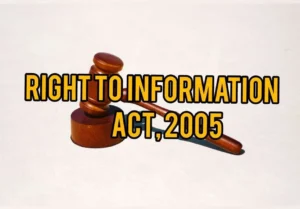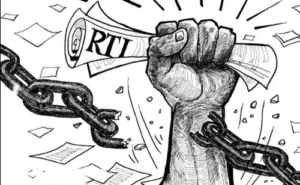Right to Information Act 2005: Complete Guide to RTI in India
The Right to Information Act, 2005 (RTI Act) is a revolutionary legislation that has fundamentally transformed governance and democracy in India. It grants citizens the power to access information held by public authorities, enabling them to hold government and public institutions accountable. Transparency is a cornerstone of democratic societies, and the RTI Act provides a legal framework for transparency by empowering people to demand information on the functioning of public bodies.

The affairs of government before the implementation of the RTI Act have been very secretive, which resulted in inefficiency, corruption, and lack of attachment between the citizens and the administration. RTI Act was a reaction to the need to be open and responsive when it comes to the affairs of the people.
History of the Right to Information Act, 2005
The history of the Right to Information Act, 2005, is rooted in India’s democratic struggle for transparency and accountability. The demand for citizens’ access to government information gained momentum during the early 1990s, spearheaded by grassroots movements across the country. One of the most notable among these was the Mazdoor Kisan Shakti Sangathan (MKSS) in Rajasthan, which played a pivotal role in highlighting the need for an RTI law.
The MKSS was aggressive in making known the public documents in terms of wage payments and rural development schemes to reveal the inefficiency and corruption in government schemes. Their ground work activism motivated other groups and individual citizens to demand a legislation that would ensure a right to information as a fundamental instrument of democracy.
As demand increased, a number of states in India passed their RTI laws in the 1990s and early 2000s. States such as Tamil Nadu, Goa and Delhi were the first to implement laws where citizens were able to access government information on a local level. Nonetheless, there was no national law, which implied that the citizens in other areas would not have such rights.
Upon realizing the significance of this problem, the Government of India put forward the Bill on the Right to Information in Parliament which was approved in 2005. The Right to information act, 2005 was announced on June 15, 2005, and took effect in October 12, 2005. It overrode the 1923 version of the colonial-era Official Secrets Act, 1923 which had grossly limited the information flowing to the people. The RTI Act has since then proved to be an invaluable tool of enhancing democracy by enabling the citizens in holding the public authorities to account.
Procedure of Right to Information Act, 2005
The Right to Information Act, 2005 empowers Indian citizens to seek information from public authorities to promote transparency and accountability. The procedure laid down under this Act is designed to be simple and accessible, ensuring that any citizen can request information without facing unnecessary barriers.
Identify the Public Authority
Before making a request, the applicant must identify the public authority that holds the required information. This could be a government department, local body, or any organization substantially funded or controlled by the government.
Drafting the RTI Application
Under the Right to Information Act, 2005, the applicant must submit a written request specifying the information sought. The application can be made in English, Hindi, or the official language of the region. Importantly, the Act does not require the applicant to justify or explain the reason for seeking information.
Submission of Application
The application should be submitted to the Public Information Officer (PIO) appointed by the public authority. It can be submitted in person, by post, or electronically through official online portals (where available). A nominal application fee (usually ₹10) is charged as per the Act.
Time-bound Response
According to the Right to Information Act, 2005, the PIO must respond within 30 days from the receipt of the request. If the information concerns the life or liberty of a person, the reply must be given within 48 hours.
Appeals and Complaints
If the applicant does not receive information or is dissatisfied with the response, the Act provides for a two-tier appeal process:
-
First Appeal: Filed with the senior officer in the concerned department.
-
Second Appeal: Filed with the Central or State Information Commission.
Exemptions
Certain information is exempt from disclosure under Section 8 of the Right to Information Act, 2005, including information affecting national security, personal privacy, or trade secrets.
Right to Information as a Fundamental Right

The Right to Information (RTI) is not explicitly mentioned as a fundamental right in the Indian Constitution. However, the Supreme Court of India has recognized it as an intrinsic part of the fundamental right to freedom of speech and expression under Article 19(1)(a).
This recognition came through landmark judgments, such as the State of Uttar Pradesh vs. Raj Narain (1975) and later in the Secretary, Ministry of Information and Broadcasting vs. Cricket Association of Bengal (1995). The Court held that the right to know is essential for the meaningful exercise of freedom of speech and democracy.
Access to information enables citizens to make informed decisions, participate actively in governance, and hold public authorities accountable. Without transparency, democratic rights remain incomplete. The RTI Act, 2005, institutionalizes this right by providing a statutory mechanism to seek information from public authorities.
Recognizing RTI as a fundamental right strengthens its importance, placing an obligation on the state to ensure transparency and openness. It empowers citizens to challenge corruption and inefficiency, reinforcing democratic governance.
Thus, the right to information serves as a vital tool for the realization of other fundamental rights and strengthens the foundation of democracy by promoting openness, accountability, and citizen participation.
RTI Rules, 2019
The Right to Information (RTI) Rules, 2019 were notified by the Government of India to streamline and regulate the process of filing and disposing of RTI applications under the RTI Act, 2005. These rules aim to improve transparency but have also generated debate regarding their impact on the independence of Information Commissions.
Features of RTI Rules, 2019
-
Centralized Filing and Processing
The rules emphasize the use of the online portal (RTI Online) for filing applications and appeals related to the Central Government departments, encouraging digital access. -
Annual Reports by Public Authorities
Every public authority must prepare an annual report detailing the number of RTI applications received, disposed of, and the nature of complaints, to promote accountability. -
Procedure for Information Commissioners’ Appointments
The rules specify the terms and conditions of service, salary, allowances, and other service matters of the Chief Information Commissioner and Information Commissioners, including the appointment process. -
Fixed Tenure and Salaries
The tenure and salaries of Information Commissioners are fixed by the central government, a provision seen by critics as potentially affecting their autonomy. -
Fee and Charges
The rules outline the fees to be charged for filing applications and appeals and the modes of payment. -
Provision for Filing Appeals
First appeals must be made within 30 days of the initial response, second appeals can be filed with the Central or State Information Commissions. -
Disposal of Complaints
Timeframes and processes for addressing complaints and appeals are provided to enhance efficiency.
Controversies and Criticism
-
Critics argue that the rules undermine the independence of Information Commissioners by allowing the government control over their salaries and tenure.
-
Concerns over potential political influence and impact on the impartial functioning of Information Commissions have been widely voiced by RTI activists and civil society.
Impact of the Right to Information Act, 2005

The Right to Information (RTI) Act, 2005 has had a profound impact on governance, public accountability, and citizen empowerment in India. As one of the most progressive transparency laws globally, it has transformed the relationship between the state and its citizens.
Promotion of Transparency and Accountability
RTI has made government functioning more transparent by allowing citizens to access official documents, records, and decision-making processes. Public authorities are now more cautious and responsible in their work, knowing their actions can be questioned.
Empowerment of Citizens
The Act has empowered citizens especially the poor and marginalized to seek information about welfare schemes, subsidies, and entitlements. People have used RTI to get ration cards, pensions, and justice in cases of administrative delay or denial.
Exposure of Corruption and Misgovernance
RTI has played a key role in exposing several high profile scams, such as the Adarsh Housing Society scam and corruption in the Public Distribution System (PDS). It acts as a deterrent against corrupt practices in public offices.
Strengthening of Democracy
RTI promotes participatory democracy by enabling citizens to engage actively in governance. It ensures continuous accountability, not just during elections but throughout a government’s term.
Support for Journalism and Civil Society
Journalists and NGOs use RTI to gather credible information, investigate governance issues, and advocate for reforms. It has become a vital tool for evidence-based reporting and activism.
Improvement in Service Delivery
Government agencies have become more responsive and efficient due to the pressure of public scrutiny. This has led to improved service delivery in areas like health, education, and welfare schemes.
Challenges of the Right to Information Act, 2005
The Right to Information (RTI) Act, 2005, has been a landmark legislation for promoting transparency and accountability in Indian governance. However, its implementation and effectiveness have faced several significant challenges over the years. These challenges, if unaddressed, can undermine the very purpose of the Act.
Lack of Awareness Among Citizens
A large section of the population, especially in rural areas, is unaware of their rights under the RTI Act. Low literacy rates, lack of access to information, and digital divide further hinder the use of RTI by common citizens.
Delay in Providing Information
Public Information Officers (PIOs) often fail to respond within the stipulated 30-day period, causing frustration among applicants. Delays in appeals and complaints are also common due to the huge backlog in Information Commissions.
Non-Compliance by Public Authorities
Many public authorities do not comply with the proactive disclosure norms under Section 4 of the Act. They often deny information on vague or unjustified grounds, defeating the objective of transparency.
Threats and Harassment of RTI Activists
RTI users and whistleblowers frequently face harassment, threats, or even physical attacks. Dozens of RTI activists have been assaulted or killed for exposing corruption, especially in cases involving powerful interests.
Dilution of Autonomy of Information Commissions
Amendments through the RTI Rules, 2019 have raised concerns about the independence of Information Commissions, as the central government now controls their tenure and salaries, potentially affecting their impartiality.
Poor Record Management
Many government offices lack proper record-keeping and digitization, making it difficult for PIOs to retrieve and share requested information in a timely manner.
Lack of Penalties and Accountability
In several cases, PIOs escape penalties even when they delay or deny information without justification. The fear of punitive action is minimal, leading to administrative complacency.
Exclusion of Private Entities
Although private bodies performing public functions significantly impact citizens, the RTI Act does not bring them under its ambit, creating transparency gaps.
Provisions of the Right to Information Act, 2005
The Right to Information Act, 2005 was enacted to promote transparency, accountability, and citizen empowerment by providing access to information under the control of public authorities. The Act lays down clear procedures and responsibilities for both information seekers and providers.
Right to Information (Section 3)
Every Indian citizen has the right to access information from public authorities. This includes the right to inspect documents, take certified copies, and obtain data in print, electronic, or other formats.
Public Authorities (Section 2(h))
The Act defines public authorities as all government bodies at the central, state, and local levels, including ministries, departments, public sector undertakings, and bodies substantially funded by the government.
Proactive Disclosure (Section 4)
Public authorities are required to publish key information suo motu (proactively), such as organizational structure, duties of officers, budget allocations, and decision-making procedures, to reduce the need for RTI applications.
Appointment of Public Information Officers (Section 5)
Each public authority must appoint Public Information Officers (PIOs) and Assistant PIOs to process and respond to information requests.
Procedure for Requesting Information (Sections 6 & 7)
Citizens can submit RTI requests in writing or electronically with a nominal fee (usually ₹10). Information must be provided within 30 days, or 48 hours if it concerns life or liberty.
Exemptions from Disclosure (Section 8)
Certain information is exempted from disclosure to protect national security, privacy, and commercial interests. However, if the public interest outweighs the harm, disclosure may still be allowed.
Third-Party Information (Section 11)
If requested information concerns a third party, their opinion must be sought before disclosure, ensuring a balance between transparency and privacy.
Appeals and Complaints (Section 19)
Applicants unsatisfied with a response can file a first appeal with a senior officer, and a second appeal with the Central or State Information Commission.
Penalties (Section 20)
PIOs who fail to provide information without just cause may face a fine of ₹250 per day, up to ₹25,000.
Criticism of the Right to Information Act, 2005
The Right to Information (RTI) Act, 2005, is considered a landmark law that empowered citizens to demand transparency and accountability from public authorities. However, despite its many achievements, the Act has faced substantial criticism from civil society, activists, legal experts, and bureaucrats.
Weakening Through Amendments
The RTI (Amendment) Act, 2019 allowed the central government to determine the tenure, salaries, and service conditions of the Chief Information Commissioner (CIC) and Information Commissioners. This change was widely criticized for undermining the independence of the Information Commissions, potentially making them vulnerable to political influence.
Safety Concerns for RTI Activists
Numerous RTI activists across India have faced threats, attacks, and even murder for exposing corruption and irregularities. The Act provides no protection or whistleblower safeguards, making activism risky and discouraging its use in sensitive matters.
Misuse of RTI
Some critics argue that the Act is occasionally used to harass public officials, demand irrelevant information, or settle personal scores. Frivolous and repetitive applications burden the already stretched public information system.
Lack of Awareness and Accessibility
Large sections of the population, especially in rural areas, remain unaware of their rights under the Act. Illiteracy, lack of digital access, and language barriers further limit its outreach and use.
Non-Compliance and Poor Implementation
Many public authorities fail to follow Section 4, which mandates proactive disclosure of key information. Additionally, some departments deliberately delay or deny information, citing vague reasons or misusing the exemption clauses under Section 8.
Overburdened Information Commissions
With the growing number of applications of RTI and grievances, Central and State Information Commissions have huge backlogs, which lead to the process of the appeals taking a long time.
Conclusion
The Right to Information Act, 2005, remains one of the most powerful tools in India’s democratic arsenal. It has transformed transparency, governance, and citizen empowerment. However, to realize its full potential, the government must ensure the independence of Information Commissions, protect RTI activists, enhance public awareness, and strictly enforce the law. Transparency is essential for a vibrant democracy, and the RTI Act is the beacon guiding India toward accountable and participatory governance.
